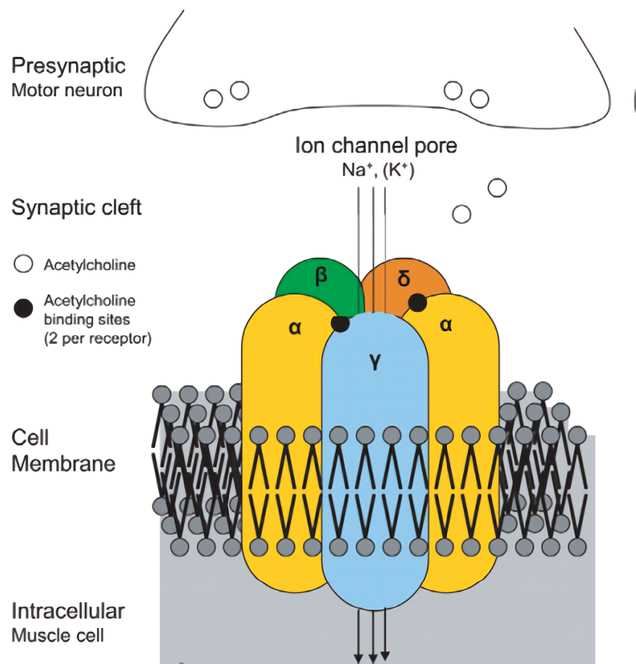Introduction of CHRNG
CHRNG, also known as acetylcholine receptor subunit gamma (ACHRG), encoded by the CHRNG gene, is one of the subunits of the acetylcholine receptor (AChR). CHRNG gene is located on chromosome 1, spans 6.5 kb, and contains 12 exons and 11 introns in the mouse. Mammalian muscle nicotinic acetylcholine receptor (AChR) consists of four membrane-spanning subunits and its composition differs between embryonic and adult muscles. In embryonic muscles, it includes two α, one β, one δ, and one γ subunit; the γ subunit is later replaced by the ε-subunit during postnatal development. This unique temporal expression pattern of γ-subunit suggests it may play specific roles in embryonic muscles. In the absence of a γ-subunit, the combination of α, β and δ subunits can be assembled into a functional receptor in vivo.
| Basic Information of CHRNG | |
| Protein Name | Acetylcholine receptor subunit gamma |
| Gene Name | CHRNG |
| Aliases | ACHRG |
| Organism | Homo sapiens (Human) |
| UniProt ID | P07510 |
| Transmembrane Times | 5 |
| Length (aa) | 517 |
| Sequence | MHGGQGPLLLLLLLAVCLGAQGRNQEERLLADLMQNYDPNLRPAERDSDVVNVSLKLTLTNLISLNEREEALTTNVWIEMQWCDYRLRWDPRDYEGLWVLRVPSTMVWRPDIVLENNVDGVFEVALYCNVLVSPDGCIYWLPPAIFRSACSISVTYFPFDWQNCSLIFQSQTYSTNEIDLQLSQEDGQTIEWIFIDPEAFTENGEWAIQHRPAKMLLDPAAPAQEAGHQKVVFYLLIQRKPLFYVINIIAPCVLISSVAILIHFLPAKAGGQKCTVAINVLLAQTVFLFLVAKKVPETSQAVPLISKYLTFLLVVTILIVVNAVVVLNVSLRSPHTHSMARGVRKVFLRLLPQLLRMHVRPLAPAAVQDTQSRLQNGSSGWSITTGEEVALCLPRSELLFQQWQRQGLVAAALEKLEKGPELGLSQFCGSLKQAAPAIQACVEACNLIACARHQQSHFDNGNEEWFLVGRVLDRVCFLAMLSLFICGTAGIFLMAHYNRVPALPFPGDPRPYLPSPD |
Function of CHRNG Membrane Protein
Typically, the γ subunit is expressed during the embryonic and neonatal phases and is replaced by the ε-subunit during the first 2 weeks after birth. The physiological role of this transformation is unclear, but there is evidence that the γ subunit and the ε subunit both plays a specific role in the embryonic and adult neuromuscular junction, respectively. In addition, the γ-subunit in embryonic helps to establish the primary encounter of muscle and axon. Thus, the γ subunit not only contributes to neuromuscular signal transduction but also plays an important role in neuromuscular organogenesis. Impaired γ-subunit structure leads to abnormal AChR function in fetal life with reduced prenatal muscle strength and movement. Moreover, the γ-subunit may be involved in interacting with rapsyn, a cytoplasmic protein required for receptor clustering. What’s more, the γ-subunit mutation prevents the correct localization of fetal AChR in the human embryonic kidney cell membranes, and the expression pattern in prenatal mice corresponds to the human clinical phenotype. In conclusion, γ-subunit of muscle nicotinic AChR plays an important role in neuromuscular development, neuromuscular signal transduction, neuromuscular organogenesis, ligand binding, and insertion of receptors in the membrane.
 Fig.1 Structure and subunit composition of fetal AChR in muscle cells. (Hoffmann, 2006)
Fig.1 Structure and subunit composition of fetal AChR in muscle cells. (Hoffmann, 2006)
Application of CHRNG Membrane Protein Literature
This article suggests muscle synaptic function is first attributed to receptor isoforms consisting of only three distinct subunits and the unique functional features provided by the α(2)βδ(2) receptor may play a central role in mediating the sustained contractile characteristics of this muscle type.
This article concludes that Escobar syndrome is an inherited fetal myasthenic disease that also affects neuromuscular organogenesis.
This article demonstrates that the gamma-subunit is shown to be essential for the formation of pre-patterned AChR clusters, which in turn plays an important role in determining subsequent patterns of neuromuscular synapse development.
This article suggests that functional AChRs are present in mutant muscle membranes and in the absence of a gamma-subunit, and the combination of α, β, and δ subunits can be assembled into a functional receptor in vivo.
This article reveals three transcriptional variants of the γ-subunit of the nicotinic AChR and their similarities and differences.
CHRNG Preparation Options
Membrane protein studies have advanced significantly over the past few years. Based on our versatile Magic™ membrane protein production platform, we could offer a series of membrane protein preparation services for worldwide customers in reconstitution forms as well as multiple active formats. Aided by our versatile Magic™ anti-membrane protein antibody discovery platform, we also provide customized anti-CHRNG antibody development services.
During the past years, Creative Biolabs has successfully generated many functional membrane proteins for our global customers. We are very honored to accelerate the development of our clients’ programs with our one-stop, custom-oriented service. For more detailed information, please feel free to contact us.
Reference
All listed services and products are For Research Use Only. Do Not use in any diagnostic or therapeutic applications.